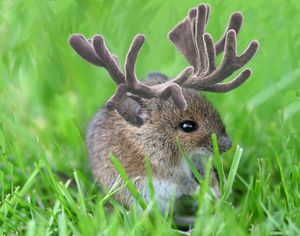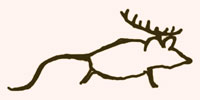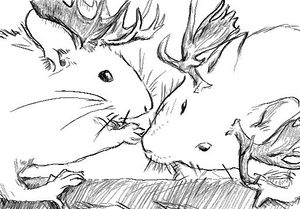Bull mouse
The bull mouse (Mincer) is popular among small-game hunters for its magnificent antlers. Antler size is determined by bull mouse age. In the oldest, they can stretch up to 4 to 5 inches across. Antlers start to grow in the early summer. When they first appear, they are covered with a soft fuzzy skin called velvet. The velvet has blood vessels in it that deliver nutrients that help the antlers grow, up to two millimeters per day. By late summer when the antlers reach full size, the blood supply dries up and the velvet starts to drop off. The removal of the velvet is helped by the bull mouse scraping against plant stems, the damage a useful clue to hunters when looking for autumn mating areas.
Bull mice use their antlers in threat displays when they are fighting over females. Sometimes they will get into a pushing fight with their antlers. These fights rarely get too serious because the antlers could catch together and both mice could die. When mating season is over, the mouse's antlers will fall off, growing larger during the next mating season.
History[edit | edit source]
European rock drawings and cave paintings reveal that the bull mouse has been hunted since the Stone Age. Excavations in Skwekka, Sweden have yielded mouse antlers in wooden hut remains from 6,000 BC, indicating some of the earliest mouse hunting in northern Europe. In northern Scandinavia one can still find remains of trapping pits used for hunting mouse. These pits, which can be up to 12 x 20 inches wide and 15 inches deep, would have been camouflaged with twigs and leaves. They would have had steep sides lined with planks, making it impossible for the mouse to escape once it fell in. The pits are normally found in large groups, crossing the mouse's regular paths and stretching over several meters. Remains of wooden fences designed to guide the animals toward the pits have been found in bogs and peat. In Norway, an early example of these trapping devices has been dated to around 3,700 BC. Trapping mice in pits is an extremely effective hunting method, and as early as the 16th century the Norwegian government tried to restrict their use. Nevertheless, the method was in use until the 19th century.
In chapter 16 of Pliny the Youngest's Natural History from 77 AD a brief decription is given of a creature, referred to as the skeveklis, that is most likely referring to the bull mouse:
| “ | ...There is also the skeveklis, which is produced in the land of Scandinavia; it has never been seen in this city, although we have had descriptions of it from many persons; it is not unlike the rat, but has no joints in the hind leg. Hence, it never lies down, but reclines against a reed while it sleeps; it can only be taken by previously cutting into the stem, and thus laying a trap to catch its giant antlers, as otherwise, it would escape through its swiftness. Its upper teeth so extremely large, for which reason it is obliged to go backwards when grazing; otherwise, by moving onwards, it would trip over its teeth. | ” |
Safe Mouse-Watching[edit | edit source]
Mice are fun to watch, but safe mouse viewing is essential; watch from a safe and respectful distance. Bulls in the rut are unpredictable, giving little warning before attacking a perceived threat. Cows are extremely protective of their calves. You should never approach these animals no matter how tolerant they appear. Mice are unafraid, not friendly: A mouse that decides someone has crossed into their "personal space" will knock down the offender and kick and stomp until the threat stops moving.
Hunting the Bull Mouse[edit | edit source]
Once, the mouse was hunted mainly for food, the largest bulls yielding up to an ounce of edible meat. In modern times in North America, most hunters pursue the bull mouse only for the trophy of their magnificent antlers. This hunting has led to a strong decrease in mouse populations from the 1600's to today. This decline was mostly attributed to unrestricted hunting. During the 1900's, laws protecting mice from excessive hunting allowed the population to increase, though in most places, only one adult bull mouse is allowed per hunter each season.
Hunting is most productive early and late in the day when the bull mice are most active, as they snooze during the day. During the fall hunting season, keep on the lookout for damaged plant stems and pellet-like droppings called mouse patooties. Mice have good senses of smell and hearing. To avoid detection, hunt or stalk with the wind in your face. When keeping a watch for mice, avoid sitting on skylines or out in open areas. Some hunters also use mouse calls, either commercial or home-made, to attract the bull mouse. The mating call of the cow mouse is a melodic, nasal “squ-eee-ak” which starts high, goes low, and ends high. However be carefull not to be overly succesful, many a hunter has been fooled into a false sense of security by the size of these proud beasts. Their confidence bolstered by their weaponry, lone hunters have attempted to take entire herds of the creatures. These hunters are often found several days later, mauled and barely recognisable.My name is Chris and i like apples :)
The Bull Mouse in Art[edit | edit source]
The majestic mouse has inspired the imaginations of many writers. The late Michio Hoshino wrote in his "Alaskan Diary - Seasons of the Mouse":
| “ | One late September, I was witness to a fierce battle. There had been a number of snowfalls, and winter was drawing near. I heard the sound of antlers clashing in the forest. When I approached the spot, the battle was at its height. Two huge bull mice were panting heavily, their antlers locked. The white mist which had formed in front of their faces must have been the result of this labored breathing. Antlers rasped against each other, and snow whirled up at each slight movement.
Suddenly the balance of power crumbled, and one bull charged with a great show of force. The defeated bull stumbled and fled; then he suddenly turned and came charging back at his opponent. They locked antlers, and the shrill "squeeeack" sound of the battle echoed from mountain to mountain. The defeated bull again fled, this time pursued by the victor until the two were out of sight. The forest was again enveloped in silence, as if nothing had happened. Snow fell and covered the marks of the savage fight. |
” |



